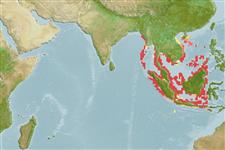Common names from other countries
>
Ovalentaria/misc (Various families in series Ovalentaria) >
Pomacentridae (Damselfishes) > Pomacentrinae
Etymology: Amphiprion: Greek, amphi = on both sides + Greek, prion, -onos = saw (Ref. 45335).
More on author: Bloch.
Environment: milieu / climate zone / djupintervall / distribution range
Ekologi
marina revassocierade; ej vandrande; djupintervall 2 - 15 m (Ref. 9710). Tropical; 20°N - 11°S, 91°E - 119°E
Eastern Indian Ocean: Andaman and Nicobar Islands, Thailand, Malaysia, and Java and Sumatra in Indonesia.
Size / Vikt / Age
Könsmognad: Lm ? range ? - ? cm
Max length : 14.0 cm TL hane/ej könsbestämd; (Ref. 9710); rapporterad maxålder: 16 år (Ref. 72479)
Short description
Bestämningsnycklar | Morfologi | Morfometri
Taggstrålar i ryggfenan (totalt) : 10 - 11; Mjukstrålar i ryggfenan (totalt) : 16 - 18; Taggstrålar i analfenan: 2; Mjukstrålar i analfenan: 13 - 14.
Body shape (shape guide): short and / or deep; Cross section: compressed.
Adults are found in silty coastal waters and protected bays where visibility is often reduced. Usually found in pairs (Ref. 48636). Oviparous, distinct pairing during breeding (Ref. 205). Eggs are demersal and adhere to the substrate (Ref. 205). Males guard and aerate the eggs (Ref. 205). Associated with the anemones: Entacmaea quadricolor and Heteractis crispa (Ref. 5911). Has been reared in captivity (Ref. 35413, 35420).
Life cycle and mating behavior
Könsmognad | Reproduktion | Lek | Ägg | Fecundity | Larver
Oviparous, distinct pairing during breeding (Ref. 205). Eggs are demersal and adhere to the substrate (Ref. 205). Males guard and aerate the eggs (Ref. 205). Also Ref. 7471.
Allen, G.R., 1991. Damselfishes of the world. Mergus Publishers, Melle, Germany. 271 p. (Ref. 7247)
IUCN Red List Status (Ref. 130435: Version 2025-1)
Threat to humans
Harmless
Human uses
Fiskeri: kommersiell; Akvarium: Kommersiell
Verktyg
Special reports
Download XML
Internet-källor
Estimates based on models
Preferred temperature (Ref.
123201): 28.4 - 29.3, mean 28.9 °C (based on 593 cells).
Phylogenetic diversity index (Ref.
82804): PD
50 = 0.5000 [Uniqueness, from 0.5 = low to 2.0 = high].
Bayesian length-weight: a=0.02344 (0.01134 - 0.04848), b=2.98 (2.80 - 3.16), in cm total length, based on LWR estimates for this (Sub)family-body shape (Ref.
93245).
Trofisk nivå (Ref.
69278): 2.7 ±0.31 se; based on food items.
Resiliens (Ref.
120179): Hög, lägsta populationsfördubblingstid mindre än 15 månader (Preliminary K or Fecundity.).
Fishing Vulnerability (Ref.
59153): Low vulnerability (10 of 100).
🛈
Nutrients (Ref.
124155): Calcium = 97.4 [49.9, 153.2] mg/100g; Iron = 0.717 [0.437, 1.159] mg/100g; Protein = 18.3 [17.1, 19.4] %; Omega3 = 0.103 [0.063, 0.165] g/100g; Selenium = 21.7 [12.4, 40.6] μg/100g; VitaminA = 81.3 [23.0, 265.6] μg/100g; Zinc = 1.67 [1.14, 2.41] mg/100g (wet weight);
